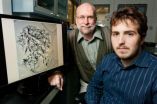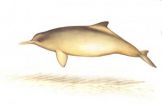(Press-News.org) CHAMPAIGN, Ill. — Fortified with iron: It's not just for breakfast cereal anymore. University of Illinois researchers have demonstrated a simpler method of adding iron to tiny carbon spheres to create catalytic materials that have the potential to remove contaminants from gas or liquid.
Civil and environmental engineering professor Mark Rood, graduate student John Atkinson and their team described their technique in the journal Carbon.
Carbon structures can be a support base for catalysts, such as iron and other metals. Iron is a readily available, low-cost catalyst with possible catalytic applications for fuel cells and environmental applications for adsorbing harmful chemicals, such as arsenic or carbon monoxide. Researchers produce a carbon matrix that has many pores or tunnels, like a sponge. The large surface area created by the pores provides sites to disperse tiny iron particles throughout the matrix.
A common source of carbon is coal. Typically, scientists modify coal-based materials into highly porous activated carbon and then add a catalyst. The multi-step process takes time and enormous amounts of energy. In addition, materials made with coal are plagued by ash, which can contain traces of other metals that interfere with the reactivity of the carbon-based catalyst.
The Illinois team's ash-free, inexpensive process takes its carbon from sugar rather than coal.
In one continuous process, it produces tiny, micrometer-sized spheres of porous, spongy carbon embedded with iron nanoparticles – all in the span of a few seconds.
"That's what really sets this apart from other techniques. Some people have carbonized and impregnated with iron, but they have no surface area. Other people have surface area but weren't able to load it with iron," Atkinson said. "Our technique provides both the carbon surface and the iron nanoparticles."
The researchers built upon a technique called ultrasonic spray pyrolysis (USP), developed in U. of I. chemistry professor Kenneth Suslick's lab in 2005. Suslick used a household humidifier to make fine mist from a carbon-rich solution, then directed the mist through an extremely hot furnace, which evaporated the water from each droplet and left tiny, highly porous carbon spheres.
Atkinson used USP to make his carbon spheres, but added an iron-containing salt to a carbon-rich sugar solution. When the mist is piped into the furnace, the heat stimulates a chemical reaction between the solution ingredients that creates carbon spheres with iron particles dispersed throughout.
"We were able to take advantage of Dr. Suslick's USP technique, and we are building upon it by simultaneously impregnating the porous carbons with metal nanoparticles," Atkinson said. "It's simple because it's continuous. We can isolate the carbon, add pores, and impregnate iron into the carbon spheres in a single step."
Another advantage of the USP technique is the ability to create materials to address particular needs. By fabricating the material from scratch, rather than trying to modify off-the-shelf products, scientists and engineers can develop materials for specific problem-solving scenarios.
"Right now, you take coal out of the ground and modify it. It's difficult to tailor it to solve a particular air quality problem," Rood said. "We can readily change this new material by how it's activated to tailor its surface area and the amount of impregnated iron. This method is simple, flexible and tailorable."
Next, the researchers will explore applications for the material. Rood and Atkinson have received two grants from the National Science Foundation to develop the carbon-iron spheres to remove nitric oxide, mercury, and dioxin from gas streams – bioaccumulating pollutants that have caused concern as emissions from combustion sources.
Currently, the three pollutants can be dealt with separately by carbon-based adsorbents and catalysts, but the Illinois team and collaborators in Taiwan hope to harness carbon's adsorption properties and iron's reactivity to remove all three pollutants from gas streams simultaneously.
"We're looking at taking advantage of their porosity and, ideally, their catalytic applications as well," Atkinson said. "Carbon is a very versatile material. What's in my mind is a multi-pollutant control where you can use the porosity and the catalyst to tackle two problems at once."
INFORMATION:
EPRI, the National Science Foundation, the U.S. Department of Energy, the Air and Waste Management Association, and the University of Illinois supported this work. Co-authors included Suslick, graduate student Maria Fortunato, and researchers from the Illinois State Geological Survey.
Editor's note: To contact Mark Rood, call 217-333-6963; e-mail mrood@illinois.edu. To reach John Atkinson, e-mail jdatkins@illinois.edu.
The paper, "Synthesis and Characterization of Iron-impregnated Porous Carbon Spheres Prepared by Ultrasonic Spray Pyrolysis," is available online or from the News Bureau.
New method for making tiny catalysts holds promise for air quality
2010-12-16
ELSE PRESS RELEASES FROM THIS DATE:
Researchers discover compound with potent effects on biological clock
2010-12-16
Using an automated screening technique developed by pharmaceutical companies to find new drugs, a team of researchers from UC San Diego and three other research institutions has discovered a molecule with the most potent effects ever seen on the biological clock.
Dubbed by the scientists "longdaysin," for its ability to dramatically slow down the biological clock, the new compound and the application of their screening method to the discovery of other clock-shifting chemicals could pave the way for a host of new drugs to treat severe sleep disorders or quickly reset the ...
Membership in many groups leads to quick recovery from physical challenges
2010-12-16
Los Angeles, CA (December 15, 2010) Being a part of many different social groups can improve mental health and help a person cope with stressful events. It also leads to better physical health, making you more able to withstand—and recover faster from—physical challenges, according to a study in the current Social Psychological and Personality Science (published by SAGE).
Belonging to groups, such as networks of friends, family, clubs and sport teams, improves mental health because groups provide support, help you to feel good about yourself and keep you active. But ...
Concussed high school athletes who receive neuropsychological testing sidelined longer
2010-12-16
Los Angeles, CA (December 15, 2010) When computerized neuropsychological testing is used, high school athletes suffering from a sports-related concussion are less likely to be returned to play within one week of their injury, according to a study in The American Journal of Sports Medicine (published by SAGE). Unfortunately, concussed football players are less likely to have computerized neuropsychological testing than those participating in other sports.
A total of 544 concussions were recorded by the High School Reporting Information Online surveillance system during ...
New study about Arctic sea-ice, greenhouse gases and polar bear habitat
2010-12-16
ANCHORAGE, Alaska – Sea-ice habitats essential to polar bears would likely respond positively should more curbs be placed on global greenhouse gas emissions, according to a new modeling study published today in the journal, Nature.
The study, led by the U.S. Geological Survey, included university and other federal agency scientists. The research broke new ground in the "tipping point" debate in the scientific community by providing evidence that during this century there does not seem to be a tipping point at which sea-ice loss would become irreversible.
The report ...
Meteorite just one piece of an unknown celestial body
2010-12-16
Washington, D.C.—Scientists from all over the world are taking a second, more expansive, look at the car-sized asteroid that exploded over Sudan's Nubian Desert in 2008. Initial research was focused on classifying the meteorite fragments that were collected two to five months after they were strewn across the desert and tracked by NASA's Near Earth Object astronomical network. Now in a series of 20 papers for a special double issue of the journal Meteoritics and Planetary Science, published on December 15, researchers have expanded their work to demonstrate the diversity ...
Where unconscious memories form
2010-12-16
A small area deep in the brain called the perirhinal cortex is critical for forming unconscious conceptual memories, researchers at the UC Davis Center for Mind and Brain have found.
The perirhinal cortex was thought to be involved, like the neighboring hippocampus, in "declarative" or conscious memories, but the new results show that the picture is more complex, said lead author Wei-chun Wang, a graduate student at UC Davis.
The results were published Dec. 9 in the journal Neuron.
We're all familiar with memories that rise from the unconscious mind. Imagine looking ...
New research shows dolphin by-catch includes genetic relatives
2010-12-16
Dolphins along coast of Argentina could experience a significant loss of genetic diversity because some of the animals that accidently die when tangled in fishing nets are related. According to a new genetic analysis published this week in the journal PLoS One, Franciscana dolphins that die as by-catch are more than a collection of random individuals: many are most likely mother-offspring pairs. This result, which suggests reduced genetic diversity and reproductive potential, could have significant implications for the conservation of small marine mammals.
"It has always ...
Polar bears: On thin ice? Extinction can be averted, scientists say
2010-12-16
Polar bears were added to the threatened species list nearly three years ago when their icy habitat showed steady, precipitous decline because of a warming climate.
But it appears the Arctic icons aren't necessarily doomed after all, according to results of a study published in this week's issue of the journal Nature.
The findings indicate that there is no "tipping point" that would result in unstoppable loss of summer sea ice when greenhouse gas-driven warming rises above a certain threshold.
Scientists from several institutions, including the U.S. Geological Survey ...
Vitamin D and parathyroid hormone levels may not affect cardiovascular mortality
2010-12-16
New York, NY, December 15, 2010 – There is burgeoning public interest in possible wide-ranging health benefits from vitamin D, including cardiovascular health. In a study published in the December 2010 issue of The American Journal of Medicine, investigators found that there was no independent association between serum levels of vitamin D or parathyroid hormone and cardiovascular mortality in this prospective study, the first in a population of older community-dwelling adults with a low prevalence of vitamin D deficiency and a broad range of kidney function.
Researchers ...
Nanomaterials in our environment
2010-12-16
Madison, WI DECEMBER 15, 2010 -- The manufacturing of nanomaterials has been steadily on the rise in the medical, industrial, and scientific fields. Nanomaterials are materials that are engineered to have dimensions less than 100 nanometers and have very unique properties as a result of their small size.
In a study funded by the U.S. Environmental Protection Agency, a team of scientists from the University of Kentucky determined that earthworms could absorb copper nanoparticles present in soil.
One crucial step in determining the uptake of nanomaterials was discerning ...

